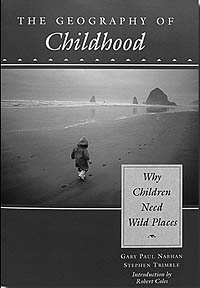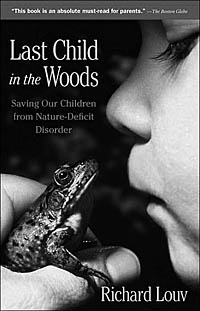How Nature Nurtures Children
Call of the Wild

Two books have recently given voice to some of my unspoken, but deeply felt beliefs about how we are shaped by our environment from the earliest moments of our lives. The nature-versus-nurture debate has continued to ride a see-saw of academic research into every facet of children’s early education and home circumstance. Lately, a new factor that has been mostly uninvestigated has surfaced in a variety of arenas. It is the profound effect that early exposure and immersion in the natural world seems to have on children. It can influence everything from how they handle stress, remain focused even when they are indoors, take responsibility for their actions on all levels, and even find their own calling in life. These books will be of inspiration to parents, teachers (at all levels of education), and environmentalist and conservationist groups of every sort. The tomes investigate the importance of early introduction to nature for mental health, a sense of connection to the physical world, and a commitment to preserving what is left of it. But if a child has never turned over a rock for himself to find the beetle burrowed beneath, if she has never had a place to build her own lean-to and find the calming solace of the world outside of the daily frenzy in which most of us live, the mature individual will be unable to resist the forces that can and will change our world from a sustainable natural system into an artificial (and probably unsustainable) world.

The Geography of Childhood: Why Children Need Wild Places (1994), by Gary Paul Nabhan and Stephen Trimble, is a meditation on their own experiences with nature as children-experiences that have informed their adult lives by kindling a life-changing connection to the natural world that increasingly few people feel today. The authors also chronicle their attempts to inculcate their own children with the same respect for nature that they hope will lead them to not only enjoy their own life journey, but also work toward the rescue of what is daily being lost by the need to house and feed a burgeoning human population, mitigate human-induced climate change, and understand such natural forces as desertification. In alternating voices, they acknowledge the different perspective that children have about nature. It’s usually not about the beautiful scenery, but rather about the intimate places they create or find where they can hide from the larger world. The small crack between the magnificent stone formations holds more appeal than the color of the sunset on the rock face. Nabhan and Trimble’s final message is that “As parents, our job is to pay attention, to create possibilities-to be careful matchmakers between our children and the Earth.”

Richard Louv greatly expands on this subject in his recent book Last Child in the Woods: Saving Our Children from Nature-Deficit Disorder (2005). Louv believes we are entering the “third frontier” in America. The first frontier ended when Americans had finally advanced-“conquering” nature-all the way from the pebbled Atlantic shingle of the New England coast to the fine sandy beaches of the Pacific. This frontier was closed, according to the 1890 census, when open land was no longer freely available to settlers. Americans continued to live with a second frontier of contact with nature for another century, as a large percentage of the population still lived on the land as farmers. When that number dropped below 2 percent in 1990, the second frontier was also gone. Louv characterizes the elements of this third frontier as “a severance in the public and private mind from our food’s origins; a disappearing line between machines, humans, and other animals; an increased intellectual understanding of our relationship with other animals; the invasion of our cities by wild animals and the rise of a new kind of suburban form.”
The core of his thesis is too many kids no longer have a place to just find nature in an unstructured (and yet safe) way. Fear of the dangers inherent in climbing trees, hiking in the woods, or just being out of sight of an adult has greatly influenced the way that children in today’s America experience nature. As a kid, my brothers and I made trails and dens in the tall grass that our dad planted as a cover crop between the rows of the orchard trees. My children had the wondrous landscape of Camp Lorr in which to ramble and build their “Indian” forts and refuges. Unfortunately, these experiences are nearly gone for most of American children. It will require a lot of rethinking and planning to bring back even a semblance of that type of experience.
Summer camps (like Camp Lorr) are dying not because educators, parents, and children no longer value the experiences they offer, but because of things like huge increases in the cost of liability insurance and property values. Parents are also, rightfully so, apprehensive about letting their children roam the neighborhood and poke into the little corners of wilderness that survive in even the most manicured communities. Random violence by adults and even older kids has increased and is a real threat. The right of children to play safely (even at home) has also been ignored, subjected to economic scrutiny and even legislated out of existence. The number of communities that no longer allow the simple act of building a tree house continues to escalate. So camps close because they cannot afford insurance, playhouses are unpermitted structures and must be torn down, and public playgrounds become sterile constructions of steel and rubberized flooring. There is no dirt, no plants, no water to excite the senses.
It turns out that we actually need these sorts of stimuli, just as we need human touch to thrive. Louv has coined the phrase “nature-deficit” because it aptly reflects the impinging neurological problems that can accompany a life devoid of the influence of nature. His (nine pages of) notes and references document the many ways that we need this connection. As he writes, “We have such a brief opportunity to pass on to our children our love for the Earth, and to tell our stories. These are the moments when the world is made whole.”
So read these books if you need inspiration, but first take a kid out to poke in the tide pools, look for salamanders in the closest creek, or turn over the rocks in their own backyard. Our future and possibly that of our world depends on it.



